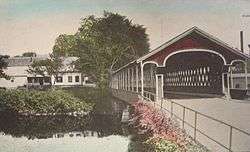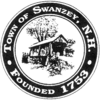Swanzey, New Hampshire
| Swanzey, New Hampshire | ||
|---|---|---|
| Town | ||
|
West Swanzey Covered Bridge c. 1915 | ||
| ||
| Motto: "Bridging Tradition and Change" | ||
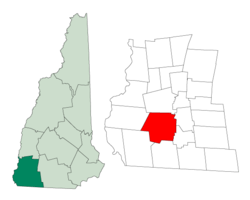 Location in Cheshire County, New Hampshire | ||
| Coordinates: 42°52′11″N 72°16′54″W / 42.86972°N 72.28167°WCoordinates: 42°52′11″N 72°16′54″W / 42.86972°N 72.28167°W | ||
| Country | United States | |
| State | New Hampshire | |
| County | Cheshire | |
| Incorporated | 1753 | |
| Government | ||
| • Board of Selectmen |
Bill Hutwelker, Chair Kenneth P. Colby, Jr. Sylvester Karasinski | |
| • Town Administrator | Michael T. Branley | |
| Area | ||
| • Total | 45.3 sq mi (117.5 km2) | |
| • Land | 45.0 sq mi (116.5 km2) | |
| • Water | 0.4 sq mi (0.9 km2) 0.79% | |
| Elevation | 492 ft (150 m) | |
| Population (2010) | ||
| • Total | 7,230 | |
| • Density | 160/sq mi (62/km2) | |
| Time zone | Eastern (UTC-5) | |
| • Summer (DST) | Eastern (UTC-4) | |
| ZIP codes |
03446 03431 (N. Swanzey)[1] 03469 (W. Swanzey) | |
| Area code(s) | 603 | |
| FIPS code | 33-75700 | |
| GNIS feature ID | 0873735 | |
| Website |
www | |
Swanzey is a town in Cheshire County, New Hampshire, United States. The population was 7,230 at the 2010 census.[2] In addition to the town center, Swanzey includes the villages of East Swanzey, West Swanzey, North Swanzey, and Westport.
History
First granted in 1733 as Lower Ashuelot, Swanzey was one of the fort towns established by Governor Jonathan Belcher of Massachusetts, which then claimed the territory. The town was the site of many battles during King George's War, and in 1747 was abandoned for three years. It was regranted to 62 proprietors on July 2, 1753 by Governor Benning Wentworth as Swanzey, most probably because some early settlers had a connection to Swansea in Wales.[3] Situated on the Ashuelot River and connected by the Ashuelot Railroad, West Swanzey developed as a textile mill town, and East Swanzey produced wooden buckets for generations. By 1859, the population was 2,106.[4]
The town features four covered bridges, and was the home of theatrical trouper Denman Thompson, who gained a national reputation by his portrayal of the Yankee farmer, "Joshua Whitcomb", star of his stage play The Old Homestead. Residents restage Thompson's melodrama every summer at a natural outdoor amphitheater called the Potash Bowl.[5]
Because he vacationed in Swanzey during several summers, the town has claimed to be the location of a tree that inspired poet Joyce Kilmer (1886–1918) to write the popular 1913 poem "Trees". However, family accounts and documents establish that the poem was written in Mahwah, New Jersey.[6][7][8]
 Post Office c. 1915
Post Office c. 1915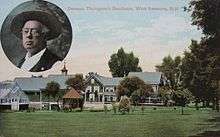 Denman Thompson's residence in 1907
Denman Thompson's residence in 1907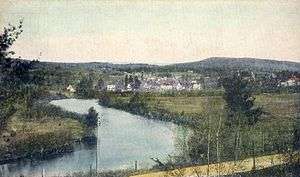 Ashuelot River c. 1915
Ashuelot River c. 1915
Geography
According to the United States Census Bureau, the town has a total area of 45.3 square miles (117 km2), of which 45.0 sq mi (117 km2) is land and 0.4 sq mi (1.0 km2) is water, comprising 0.79% of the town. Swanzey is drained by the Ashuelot River. The town's highest point is the summit of Franklin Mountain at 1,423 feet (434 m) above sea level, on the border with Winchester.
The town is crossed by New Hampshire Route 10, New Hampshire Route 12 and New Hampshire Route 32.
Demographics
| Historical population | |||
|---|---|---|---|
| Census | Pop. | %± | |
| 1790 | 1,157 | — | |
| 1800 | 1,271 | 9.9% | |
| 1810 | 1,400 | 10.1% | |
| 1820 | 1,716 | 22.6% | |
| 1830 | 1,816 | 5.8% | |
| 1840 | 1,755 | −3.4% | |
| 1850 | 2,106 | 20.0% | |
| 1860 | 1,798 | −14.6% | |
| 1870 | 1,626 | −9.6% | |
| 1880 | 1,661 | 2.2% | |
| 1890 | 1,600 | −3.7% | |
| 1900 | 1,570 | −1.9% | |
| 1910 | 1,656 | 5.5% | |
| 1920 | 1,593 | −3.8% | |
| 1930 | 2,066 | 29.7% | |
| 1940 | 2,262 | 9.5% | |
| 1950 | 2,806 | 24.0% | |
| 1960 | 3,626 | 29.2% | |
| 1970 | 4,254 | 17.3% | |
| 1980 | 5,183 | 21.8% | |
| 1990 | 6,236 | 20.3% | |
| 2000 | 6,800 | 9.0% | |
| 2010 | 7,230 | 6.3% | |
| Est. 2015 | 7,203 | [9] | −0.4% |
As of the census[11] of 2000, there were 6,800 people, 2,666 households, and 1,874 families residing in the town. The population density was 151.1 people per square mile (58.4/km²). There were 2,818 housing units at an average density of 62.6 per square mile (24.2/km²). The racial makeup of the town was 98.32% White, 0.18% African American, 0.24% Native American, 0.53% Asian, 0.01% Pacific Islander, 0.13% from other races, and 0.59% from two or more races. Hispanic or Latino of any race were 0.56% of the population.
There were 2,666 households out of which 33.0% had children under the age of 18 living with them, 57.0% were married couples living together, 9.2% had a female householder with no husband present, and 29.7% were non-families. 22.5% of all households were made up of individuals and 8.4% had someone living alone who was 65 years of age or older. The average household size was 2.55 and the average family size was 2.97.
In the town the population was spread out with 25.1% under the age of 18, 7.0% from 18 to 24, 30.1% from 25 to 44, 24.9% from 45 to 64, and 13.0% who were 65 years of age or older. The median age was 38 years. For every 100 females there were 97.3 males. For every 100 females age 18 and over, there were 92.2 males.
The median income for a household in the town was $44,819, and the median income for a family was $51,500. Males had a median income of $32,421 versus $25,607 for females. The per capita income for the town was $20,150. About 3.0% of families and 5.4% of the population were below the poverty line, including 2.4% of those under age 18 and 10.4% of those age 65 or over.
Education
Sites of interest
- Swanzey Historical Museum
- West Swanzey Covered Bridge, built in 1832
Notable people
- Loyal B. Stearns, jurist and Oregon state representative
- Denman Thompson, playwright and actor
References
- ↑ "NORTH SWANZEY Zip Code (NH)". zip-codez.com. Retrieved 4 May 2015.
- ↑ United States Census Bureau, American FactFinder, 2010 Census figures. Retrieved March 23, 2011.
- ↑ Read, Benjamin (1892). The History of Swanzey, New Hampshire, from 1734 to 1890. Salem, Massachusetts. p. 52.
- ↑ Coolidge, Austin J.; John B. Mansfield (1859). A History and Description of New England. Boston, Massachusetts. pp. 661–663.
- ↑ New Hampshire Economic and Labor Market Information Bureau Profile
- ↑ Federal Writers' Project for the Works Progress Administration of the State of New Hampshire. New Hampshire: A Guide to the Granite State (Boston: Houghton Mifflin & Co., 1938), 103.
- ↑ Kelly, Mike. "Did Mahwah's trees inspire Joyce Kilmer's famous poem?" in The Bergen Record (26 January 2013). Retrieved 18 June 2013.
- ↑ Associated Press. "Doomed Oak Said Kilmer Poem Source" in The Berkshire Eagle (16 September 1963), 8.
- ↑ "Annual Estimates of the Resident Population for Incorporated Places: April 1, 2010 to July 1, 2015". Retrieved July 2, 2016.
- ↑ "Census of Population and Housing". Census.gov. Retrieved June 4, 2016.
- ↑ "American FactFinder". United States Census Bureau. Retrieved 2008-01-31.
External links
- Town of Swanzey official website
- Mt. Caesar Union Library
- Stratton Free Library
- New Hampshire Economic and Labor Market Information Bureau Profile
